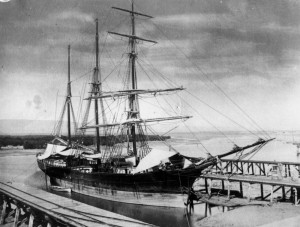Posted: August 13th, 2016 | No Comments »
I’ve posted various 1930s ads for Kodak in the past – here for their cine camera and here for the 1940 model Kodak 35 camera. Kodak were pretty much always at the same address in Shanghai – 24 Yuen Ming Yuen Road (Yuanmingyuan Road now), back behind the Bund (and, by the way, handily close to their ad agency in China, Carl Crow of course, on Jinkee/Dianchi Road).

Posted: August 12th, 2016 | No Comments »
Planning to die in Shanghai? Perhaps it’s time to resuscitate the tradition of the “Jazz Funeral”. 1934…and a prominent Chinese merchant gets a majorly face giving jazz funeral – wireless sets with loud speakers blasting American jazz. What a way to go – you can keep your paper Louis Vuitton bags! Classy as our 1934 merchant was – he wasn’t original.
Carl Crow recalled, in the 1920s, the noisy funeral processions that made their way through Shanghai playing such strange Western standards as Ta-ra-ra, Boom-de-aye and There’ll Be A Hot Time In The Old Town Tonight.

Posted: August 11th, 2016 | 1 Comment »
Coca-Cola was of course available in old Shanghai, but it wasn’t the most popular soft drink – that was Green Spot. Green Spot was a brand of bottled non-carbonated orangeade. It was developed in the US in 1934 but became phenomenally popular in Asia in the late 1930s and throughout World War Two. By the late 1930s it was already being bottled in Shanghai under license by a Cantonese called Lau Bong.


Posted: August 10th, 2016 | No Comments »
Need a car in 1930 Shanghai – try Best Car Hire. how could you not manage to hire a car with three – yes three – phone lines open and representatives prowling the lobby at both the Palace (on the Bund/Nanking Road and now the stupidly named Swatch Art Peace Hotel whatever) and the Astor over in Hongkew (now the Pujiang).

Posted: August 9th, 2016 | No Comments »
Two adverts from 1936 for Chefoo-based lace firms. Chefoo (now Yantai) was famous as a lace production centre between the wars. The story goes that a certain Reverend James Mcmillan, a missionary, decided to create a lace industry to alleviate the poverty of Chefoo. It seems the workers of Chefoo took to a bit of needlepoint and an industry was born – with all its attendant sidelines including hair nets! At least that’s if the advert from the Sydney department store Hordern Brothers (below) is to be believed (by the way the marvellous Victorian Italiante-style Hordern Brothers store was demolished in 1986 to make way for the utterly disgusting World Square – you can see many pictures of the old store here).
From its nineteenth century origins the trade flourished, even up to early communist times. Here then are Franklin Trading and Hwa Ching Ho & Co. advertising their Chefoo lace to the world.


Posted: August 6th, 2016 | 15 Comments »
The J.L. George Chinese furniture shop does indeed sound worth a visit. George’s (the apostrophe slipped on the ad below) was up on Avenue Road, now Beijing West Road, that ran parallel to the Bubbling Well Road right to the western edge of the Settlement. Like many retailers of the 1930s looking to dodge sudden rent rises (nothing new there then) George appears to have moved around – at 1475-1477 in 1930 but also listed at No.805 at times. Their telephone number was 34732, by the way.
J.L. George appeared to be obviously foreign-owned though using Chinese craftsman – mostly originating from Dongyang in Zhejiang. In fact the company was owned by Shuang Hong Tai. We could speculate why Shuang used a western name of course – issues of trust and reliability were similar then as often today. Whatever the reason, Shanghailanders made the store popular.
Shuang hired low cost rural carpenters and craftsmen and brought them to Shanghai. This was a tradition begun in the early 1900s in Hangzhou before the furniture “factories” realised the potential size of the coastal Shanghai market and the spending power of Shanghailanders. Each one of their objects was stamped “Made in China” (which had a rather better reputation then than now!). The company moved to Hong Kong in 1949 to escape the communists and remained in business for some time after that as J.L. Georges. Interestingly, looking at various adverts from the 1930s – the company switched between J.L. George and J.L. Georges quite often. Items of furniture made by J.L. George come up for auction quite often, but due to the not completely great quality, the abundance of items they produced and their relative newness they don’t attract much money. However, they are of interest as being a staple brand found in Shanghailander homes.

Occasionally items do come up for auction with a J.L. George provenance, such as the carved wooden chest below (which sold for US$375 at auction in 2010!)….and below those a collection of three J.L. George tables that went for US$234.


And some other J.L. George items….



Posted: August 5th, 2016 | No Comments »
I’ve been meaning to write something about Voicemap for a while…so here we are. Walking tours that you can download on to your mobile telephone or “device”, some are free and some cost a small fee. My own walk retracing the locations of Midnight in Peking and the 1930s city of that book is available (free) – it’s here. I note there are some other China-based walks by people who know their stuff:
Alec Ash (author of the recently published Wish Lanterns) has a stroll through the old hutongs (those that are left anyway) around the Drum and Bell Tower (here);
There’s also a walk – that I can only imagine is excellent – with Katya Knyazeva through Shanghai’s old town (again, probably best to go out and do while it’s still there!)
Hong Kong, Bangkok, Seoul, Singapore, Yokohama and other Asian destinations are also available.

Posted: August 4th, 2016 | No Comments »
I’m currently reading Hua Hsu’s A Floating Chinaman, which has a lot to say about China Watching and is rather interesting. I’ve blogged before about the American ship, The Empress of China, that left New York in 1784 for Canton to trade – an independent America’s first China bound ship. All very interesting of course, a new country, a new player in Canton, ginseng, silver and eventually a new player in the opium trade. However, I was not asware of the poem, mentioned by Hua Hsu, by Philip Freneau, On the First American Ship That Explored the Route to China and the East-Indies, After the Revolution, published in 1784 to mark the voyage of The Empress of China (pictured below after the poem). Freneau (below) was a proud American revolutionist and so equally proud of the voyage while never missing a chance to bash the Brits…

On the First American Ship That Explored the Route to China and the east-Indies, After the Revolution
Philip Freneau (1784)
She spreads her wings to meet the Sun,
Those golden regions to explore
Where George forbade to sail before.
Thus, grown to strength, the bird of Jove,
Impatient, quits his native grove,
With eyes of fire, and lightning’s force
Through the blue aether holds his course.
No foreign tars are here allow’d.
To mingle with her chosen crowd,
Who, when return’d, might, boasting say
They show’d our native oak the way.
To that old track no more confin’d,
By Britain’s jealous court assign’d,
She round the stormy cape shall sail
And eastward, catch the odorous gale.
To countries plac’d in burning climes
And islands of remotest times
She now her eager course explores,
And soon shall greet Chinesian shores.
From thence their fragrant teas to bring
Without the leave of Britain’s king;
And porcelain ware, enchas’d in gold,
The product of that finer mould.
Thus commerce to our world conveys
All that the varying taste can please;
For us, the Indian looms are free,
And Java strips her spicy tree
Great pile proceed! – and o’er the brine
May every prosperous gale be thine,
’Till, freighted deep with eastern gems,
You reach again your native streams.
















